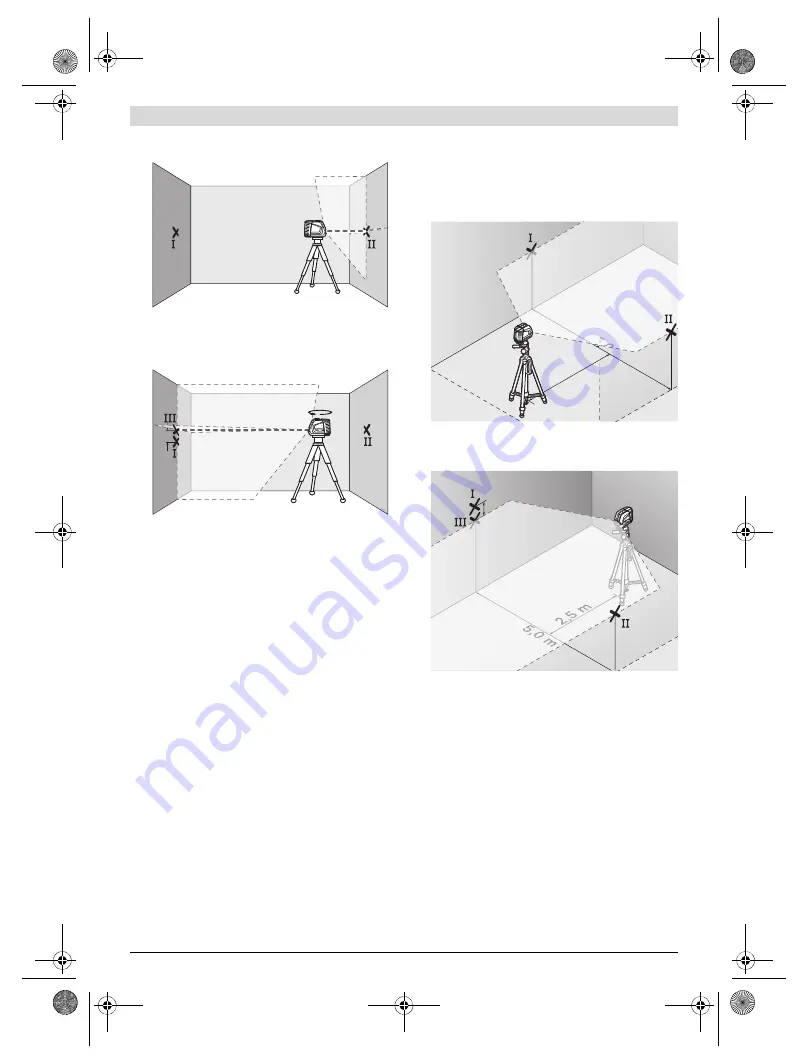
English |
15
Bosch Power Tools
1 609 92A 27R | (4.7.16)
– Without turning the measuring tool, position it close to
wall B. Switch the measuring tool on and allow it to level in.
– Align the height of the measuring tool (using a tripod or by
underlaying, if required) in such a manner that the cross
point of the laser lines is projected against the previously
marked point
II
on the wall B.
– Without changing the height, turn around the measuring
tool by 180°. Direct it against the wall A in such a manner
that the vertical laser line runs through the already marked
point
I
. Allow the measuring tool to level in and mark the
cross point of the laser lines on the wall A (point
III
).
– The difference
d
of both marked points
I
and
III
on wall A
indicates the actual height deviation of the measuring tool.
The maximum permitted deviation d
max
is calculated as fol-
lows:
d
max
= double distance of the walls x 0.3 mm/m
Example: With a 5 metre distance between the walls, the max-
imum deviation must not exceed
d
max
= 2 x 5 m x 0.3 mm/m = 3 mm. Thus, the marks must not
be more than 3 mm apart.
Checking the Levelling Accuracy of the Horizontal Line
For the check, a free surface of approx. 5 x 5 metres is re-
quired.
– Set up the measuring tool on a firm, level surface between
both walls A and B. Allow the measuring tool to level in
while in horizontal operation.
– At a distance of 2.5 metres from the measuring tool, mark
the centre of the laser line (point
I
on wall A and point
II
on
wall B) on both walls.
– Set up the measuring tool 5 metres away turned by 180°
and allow it to level in.
– Align the height of the measuring tool (using a tripod or by
underlaying, if required) in such a manner that the centre
of the laser line is projected exactly against the previously
marked point
II
on wall B.
– Mark the centre of the laser line as point
III
(vertically
above or below point
I
) on the wall A.
– The difference
d
of both marked points
I
and
III
on wall A
indicates the actual deviation of the measuring tool from
the level plane.
The maximum permitted deviation d
max
is calculated as fol-
lows:
d
max
= double distance of the walls x 0.3 mm/m
Example: With a 5 metre distance between the walls, the max-
imum deviation must not exceed
d
max
= 2 x 5 m x 0.3 mm/m = 3 mm. Thus, the marks must not
be more than 3 mm apart.
A
B
d
180˚
A
B
2,5 m
,0 m
5,
5
A
B
d
2,5 m
A
B
OBJ_BUCH-817-007.book Page 15 Monday, July 4, 2016 6:35 PM













